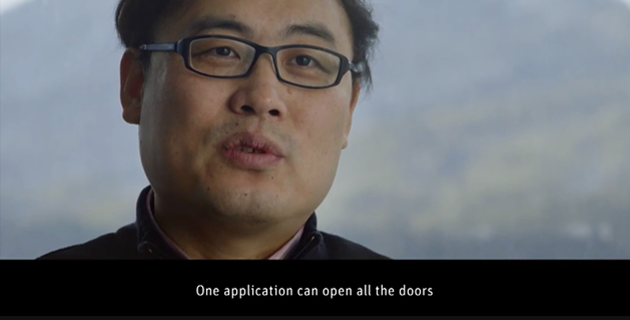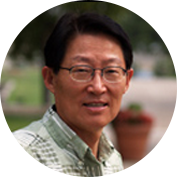Founder’s Message
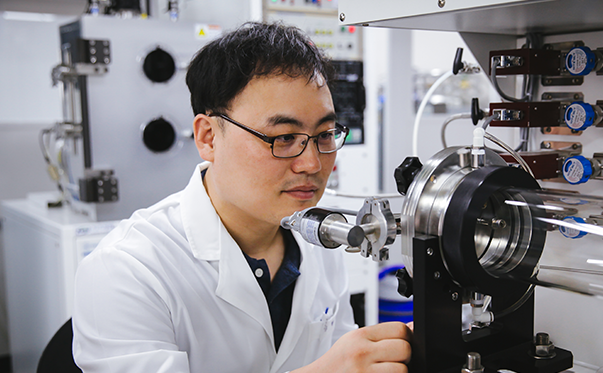
- Byung Hee Hong
Founder/Scientific Advisor
Pioneer of large-scale graphene synthesis Byung Hee Hongآ pioneered the large-scale synthesis of graphene by CVD(Chemical vapor deposition) from previously micrometer scale level, which triggered chemical research studies toward the practical applications of graphene.-
Micro Scale
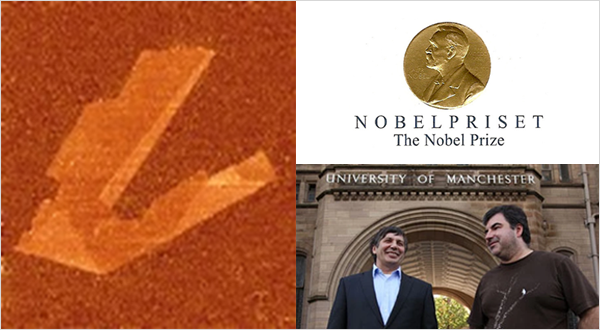 <K. Novoselov, et al.> Science (2004)
<K. Novoselov, et al.> Science (2004)
-
Meter Scale
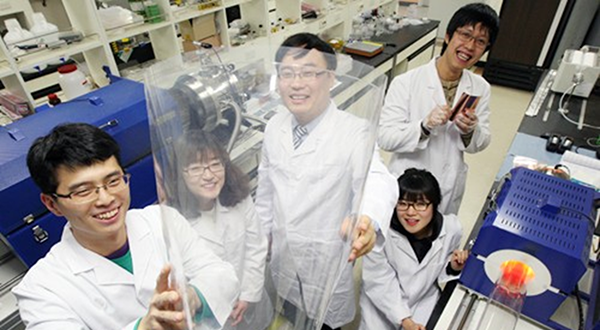 <Graphene Finally Goes Big> Science (2010)
<Graphene Finally Goes Big> Science (2010)
-
Unlimited Scale
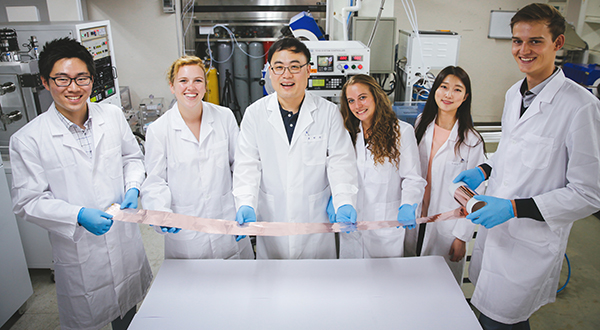 <Now Graphene Goes Limitless> (2016)
<Now Graphene Goes Limitless> (2016)
-
CVD synthesis
One of 2 essential methods of graphene synthesis
His first report on the CVD synthesis of graphene
6,000+ citation as of today (2009~)
(Natureآ 457, 706 (2009)) has recorded the world highest citations in chemistry among the papers published since 2009.

-
R2R method
Ultimate technology for graphene mass production
A year after, Byung Hee Hong developed the synthesis of ultra-large graphene based on roll-to-roll method and applied the material to flexible touch screens (Nature Nanotech.آ 5, 574-578 (2010)), which is believed to be the first demonstration of the utilization of graphene materials in practical electronic devices.آ
4,000+ citation as of today (2010~)
For this contribution,آ Byung Hee Hongآ was invited by the Nobel Committee to give a presentation in the Novel Symposium on Graphene, five months prior to the announcement of the Nobel Physics Prize on graphene in 2010. The press release by the Royal Swedish Academy has cited Byung Hee Hong’s paper as one of the major research achievements that contributed to the prize, and his achievements are being exhibited in *Nobel Museum.
Located in Stockholm Sweden, Nobel museum is a museum devoted to circulate information on the Nobel Prize, Nobel laureates from 1901 to present, and the life of the founder of the prize, Alfred Nobel (1833-1896).
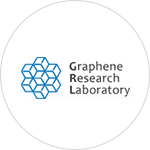
Career & Activities

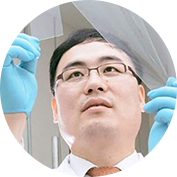
 Associate Professor, Department of Chemistry
Associate Professor, Department of Chemistry
College of Natural Sciences, Seoul National University http://www.graphene.re.kr
http://www.graphene.re.kr
-
- 2014- Visiting Associate, Department of Physics, Harvard University Director, SNU Graphene Center, Seoul National University
- 2011- Associate professor, Department of Chemistry, Seoul National Univers
- 2007 - 2011 Assistant professor, Department of Chemistry & Sungkyunkwan Advanced Institute of Nanotechnology (SAINT)
- 2004 - 2007 Post-Doc, Columbia University (Adviser: Philip Kim)
 Employment
Employment
-
- 2011 - European Graphene Flagship, strategic advisory Concil (Including 4 Nobel Laureates)
- 2012 - Cambridge University Graphene Centre, UK, External Advisory Board
- 2011 - LG Electronics, Advisory Committee for CTO
 Advisory Board
Advisory Board
-
- 2011 - 2D Materials, Institute of Physics, Regional Editor (Asia)
- 2012 - Scientific Reports, Nature Publishing Group, Editorial Board
 Journal Editor/Editorial Board
Journal Editor/Editorial Board
-
- 2016 2nd International Conference in Two-dimensional Layered Materials, Hong Kong (Plenary)
- 2015 IEEE International Electron Devices Meeting (IEDM), Washington DC, USA
- 2014 Graphene Week, Gothenburg, Sweden Gordon Research Conference, Lewiston, USA
- 2013 ACS National Meeting, New Orleans, USA
- 2012 ACS National Meeting, Philadelphia, USA
- 2012 15th International Conference on Thin Films, Kyoto, Japan (Plenary) Nature Conference "Graphene: The Road to Applications", Boston, USA (Overview)
- 2010 2010 30th International Conference on the Physics of Semiconductors (ICPS), Seoul, Korea Nobel Symposium on Graphene, Stockholm, Sweden
- 2009 APS March Meeting, Pittsburgh, USA
 Invited Talks
Invited Talks
-
- 2013 Financial Times, designated as “The Rising Star in the field of physics“
- 2010 Ph.D in Chemistry, Pohang University of Science and Technology (POSTECH) (Adviser: Kwang-soo Kim)
 Honors
Honors
- Ph. D. in Chemistry, August 2002; Pohang University of Sciene and Technology • Thesis Title : Formation and Application of Science and Technology • Thesis Adcisor. Prof. Kwang S. Kim
- B. S. in Chemistry, February 1998; Pohang University of Science and Technology
-
- 2009 POSCO Cheong-Am Bessemer Fellowship, TJ Park Foundation 2010 SKKU Young Fellowship, Sungkyunkwan University 2010 Joong-Ang Daily - Yumin Award of Science 2011 Kyung-Ahm Prize of Natural Sciences 2012 Excellent Researcher Award (Korean Chemical Society) 2012 Creative Knowledge Award (Ministry of Education, Sci. and Tech.)
 Awards
Awards
-
- 2D Materials, Institute of Physics, Regional Editor (Asia) (2013~). Scientific Reports,Nature Publishing Group, Editorial Board (2012~).
 Journal Editor/Editorial Board
Journal Editor/Editorial Board
-
- EU Graphene Flagship, Strategic Advisory Council (2011~). Cambridge Univ. Graphene Center, External Advisory Board (2013~).s LG Electronics, Advisory Committee for CTO (2012~). Graphene Square Inc., Founder & Scientific Advisory Board (2012~). Korean Graphene Commercialization Project, Planning Committee (2011~2012). Korean Graphene Hub Project, Planning Committee (2012). MELFAS Co. Ltd., Outside Director (2013.4~2015.12).
 Advisory Board/Project Committee
Advisory Board/Project Committee
-
- 2010 MRS spring meeting, San Francisco, Symposium Co-Chair 2010 Recent Advances in Graphene and Related Materials, Co-Organizer 2010 International Conference on Electronic Materials and Nanotechnology for Green Environment, Symposium Chair 2011 Recent Progress in Graphene Research, Organizing Chair 2012 Graphene Week 2012, Co-Organizer 2014 Graphene Week 2014, Scientific Advisory Board 2015 Graphene Week 2015, Scientific Advisory Board
 Conference Organizers/Symposium Chairs
Conference Organizers/Symposium Chairs
-
- 2010 Recent Advances in Graphene and Related Materials (Keynote) 2010 Korea Material Research Society Meeting (Plenary) 2010 ISEPD, Chiang Mai, Thailand (Keynote) 2010 ICNST 2010, Gwangju, Korea (Plenary) 2010 Dasan Conference on Graphene, Jeju, Korea (Opening Keynote) 2010 AVS Fall meeting, Albuquerque, NM (Tutorial) 2011 NT11, Cambridge, UK (Tutorial) 2011 Graphene 2011, Bilbao, Spain (Keynote) 2011 15th International Conference on Thin Films, Kyoto, Japan (Plenary) 2013 New Diamond and Nano Carbon 2013, Singapore (Keynote) 2013 7th World Congress on Biomimetics, Artificial Muscles and Nano-Bio (Keynote) 2016 2nd International Conference in Two-dimensional Layered Materials, Hong Kong (Plenary)
 Plenary/Keynote/Tutorial Talks
Plenary/Keynote/Tutorial Talks
-
- 2009 APS March Meeting, Pittsburgh, USA 2010 Graphene Week, Maryland, USA 2010 E-MRS Spring Meeting, Strasbourg, France 2010 International Conference on Solid State Devices and Materials (SSDM), Tokyo, Japan 2010 30th International Conference on the Physics of Semiconductors (ICPS), Seoul, Korea 2010 Nobel Symposium on Graphene, Stockholm, Sweden 2011 Graphene Week 2011, Obergurgl, Austria 2011 APS March Meeting, Dallas, TX, USA 2011 Graphene 2020: Opportunities for Europe, Brussels, Belgium 2011 Baker Symposium: The Future of Graphene Chemistry, Cornell Univ., Ithaca, USA 2011 Nature Conference "Graphene: The Road to Applications", Boston, USA (Overview) 2011 IOP Topical Research Meetings on Physics: Graphene and Related Two-Dimensonal Materials, London, UK. 2012 Graphene 2012, Brussels, Belgium- 2012 Graphene Week 2012, Delft, Netherland 2012 Graphene and Green Energy International Symposium 2012, Tianjin, China. 2012 ACS National Meeting, Philadelphia, USA. 2013 ACS National Meeting, New Orleans, USA. 2013 Chamers, AoA Conference, Marstrand, Sweden. 2013 London Business Conference on Graphene, London, UK 2014 MRS Spring Meeting, San Francisco, USA (2 invited talks) 2014 Gordon Research Conference, Lewiston, USA 2014 Graphene Week, Gothenburg, Sweden 2015 Grapchina 2015, Qingdao, China (2 invited talks) 2015 Graphene Canada 2015, Montreal, Canada (2 invited talks) 2015 IEEE International Electron Devices Meeting (IEDM), Washington DC, USA 2015 Pacifichem, Hawaii, USA 2016 China Graphene Summit, Shanghai, China
 Invited Talks
Invited Talks
Publications


 Associate Professor, Department of Chemistry
Associate Professor, Department of Chemistry
College of Natural Sciences, Seoul National University http://www.graphene.re.kr
http://www.graphene.re.kr
“Growth dynamics and gas transport mechanism of nanobubbles in graphene liquid cells,†Nature Commun. 2015, 6, 6068. “Graphene for displays that bend," Nature Nanotech. 2014, 9, 737-738. “Extremely efficient flexible organic light-emitting diodes with modified graphene anode,†Nature Photonics 2012 , 6, 105. “High-performance graphene-based transparent flexible heaters,†Nano Lett. 2011, 11, 5154. "Roll-to-roll production of 30 inch graphene films for transparent electrodes,†Nature Nanotech. 2010, 5, 574. (Cover Article) “Wafer-Scale Synthesis and Transfer of Graphene Films." Nano Lett. 2010, 10, 490-493. “Large-Scale pattern growth of graphene films for stretchable transparent electrodes,†Nature 2009, 457, 706. “Near-field focusing and magnification through self-assembled nanoscale spherical lenses,†Nature 2009, 460, 498. “Covalently bridging gaps in single-walled carbon nanotubes with conducting molecules,†Science 2006, 311, 356. “Ultrathin single-crystalline silver nanowire arrays formed in an ambient solution phase,†Science 2001, 294, 348.
View ScholarReferences from global renowned researchers


 Associate Professor, Department of Chemistry
Associate Professor, Department of Chemistry
College of Natural Sciences, Seoul National University http://www.graphene.re.kr
http://www.graphene.re.kr
 What worldwide researchers are saying about Hong Byung Hee
What worldwide researchers are saying about Hong Byung Hee
-
 Prof. Konstantin Novoselov Manchester Univ. School of Physics
Prof. Konstantin Novoselov Manchester Univ. School of Physics“Prof. Byung Hee Hong’s work helped in providing what industries require in terms of graphene commercialization.†- 2011 Electronics News Special Report -“Prof. Byung Hee Hong’s large scale synthesis research enabled receipt of the Nobel prize.†- Novoselov’s email to Prof. Byung Hee Hong -
-
 Prof. Andre Geim Manchester Univ. School of Physics
Prof. Andre Geim Manchester Univ. School of PhysicsMay 2010 - Prof. Byung Hee Hong spoke at the Nobel symposium about the large scale synthesis technique of graphene and touchscreen applications. He received high praise for showing the future of graphene. The Nobel Prize was announced five months later.- 2011 Electronics News Special Report -
-
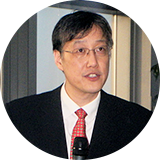 Prof. Phillip Kim Harvard Univ. School of Physics
Prof. Phillip Kim Harvard Univ. School of Physics“I am glad to see that Prof. Byung Hee Hong rejected offers from other countries in order to continue his graphene research in Korea. Graphene Square Inc. will accomplish important works as a leader in graphene material development in Korea.â€- 2012 Graphene Square Anniversary -
-
 Prof. James Hone Columbia Univ. School of Engineering
Prof. James Hone Columbia Univ. School of Engineering“In my opinion, Korea’s graphene research is at the forefront. Byung Hee Hong first developed the technique to produce graphene in mass scale and it was quite innovative. He changed people’s perspective of graphene. Within the labs, graphene was a fun and interesting research area material, but then suddenly, it was transformed into something that we can actually apply and adapt.â€- 2015 KBS “Carbon Revolution†-
Advisory Board

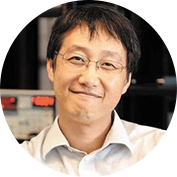
 Professor, Department of PhysicsHarvard University
Professor, Department of PhysicsHarvard University http://kim.physics.harvard.edu/
http://kim.physics.harvard.edu/
Professor Kim is a world leading scientist in the area of materials research. His research area is experimental condensed matter physics with an emphasis on physical properties and applications of nanoscale low-dimensional materials. آ The focus of Prof. Kim’s group research is the mesoscopic investigation of transport phenomena, particularly, electric, thermal and thermoelectrical properties of low dimensional nanoscale materials. These materials include carbon nanotubes, organic and inorganic nanowires, 2-dimensional mesoscopic single crystals, and single organic molecules. The use of modern state-of-the-art semiconductor device fabrication techniques and the development of new methods of material synthesis/manipulation are essential parts of this research. He has initiated these efforts very successfully, and is continuously making innovations in microscopic experimental tools and methods in order to investigate the electric, thermal/thermoelectric transport properties of the nanoscale materials. Professor Kim published more than 120 papers in professional journals which are well cited. Many of his papers are published in high impact journals such as Nature, Science and Physical Review Letters. Professor Kim received numerous honors and award including Oliver E. Buckley Prize (2014), Loeb Lectureship, Harvard (2012); Dresden Barkhausen Award (2011); Yunker Lectureship, Oregon State University, (2011); Chapman Lectureship, Rice University, (2009);آ IBM Faculty Award (2009); Ho-Am Science Prize (2008); American Physical Society Fellow (2007); Columbia University Distinguished Faculty Award (2007); Recipient Scientific American 50 (2006); National Science Foundation Faculty Career Award (2004). آ In addition, He has given more than 300 invited presentations as keynote speaker, plenary speakers, and invited speakers in international and domestic conferences, colloquiums and department seminars.آ
- Seoul National University Physics B.S. 1990
- Harvard University Applied Physics M.A. 1996
- Harvard University Applied Physics Ph.D. 1999
- University of California, Berkeley Physics Post-Doctoral Fellow 1999-2001
-
- 2014 Professor, Department of Physics, Harvard University
- 2009 - 2014 Professor, Department of Physics, Columbia University
- 2006 - 2009 Associate Professor, Department of Physics, Columbia University
- 2002 - 2006 Assistant Professor, Department of Physics, Columbia University
- 1999 - 2001 Miller Postdoctoral Fellow in Physics, University of California, Berkeley
-
- Oliver E. Buckley Condensed Matter Prize (2014) Loeb Lecture, Harvard University(2012) Dresden Barkhausen Award (2012) Yunker Lecture, Oregon State University,(2011) Scientist of the Year, Korean-American scientists and Engineers Association(2011) Chapman Lecture, Rice University, (2009) IBM Faculty Award (2009) Ho-Am Science Prize (2008) American Physical Society Fellow (2007) Columbia University Distinguished Faculty Award (2007) Recipient Scientific American 50 (2006) National Science Foundation Faculty Career Award (2004) Outstanding Young Researcher Award, Association of Korean Physicists in America (2002)
-
- Total Publications (More than 120 publications including Nature (6), Science (10), Nature Phys. (5), Nature Nanotech (4), Nature Materials (1), Phys. Rev. Letts (31), Nano Lett. (14)). Total Citation (More than 25,000, h-index: 56).
-
- 1. C. R. Dean, L. Wang, P. Maher, C. Forsythe, F. Ghahari, Y. Gao, J. Katoch, M. Ishigami, P. Moon, M. Koshino, T. Taniguchi, K. Watanabe, K. L. Shepard, J. Hone, and P. Kim, “Hofstadter's butterfly in moire superlattices: A fractal quantum Hall effect,†Nature 497, 598-602 (2013)
- 2. P. Maher, C. R. Dean, A. F. Young, T. Taniguchi, K. Watanabe, K. L. Shepard, J. Hone, and P. Kim, “Evidence for a Spin Phase Transition at Charge Neutrality in Bilayer Graphene,†Nature Physics, 9, 154-158 (2013)
- 3. A. F. Young, C. R. Dean, L. Wang, H. Ren, P. Cadden-Zimansky, K. Watanabe, T. Taniguchi, J. Hone, K.L. Shepard, and P. Kim, “Spin and valley quantum Hall ferromagnetism in graphene,†Nature Physics, 8, 553-556 (2012)
- 4. Y. Zhao, P. Cadden-Zimansky, F. Ghahari, and P. Kim, “Magnetoresistance Measurements of Graphene at the Charge Neutrality Point,†Phys. Rev. Lett. 108, 106804 (2012)
- 5. F. Ghahari, Y. Zhao, P. Cadden-Zimansky, K. Bolotin, P. Kim, “Measurement of the n = 1/3 fractional quantum Hall energy gap in suspended graphene,â€, Phys. Rev. Lett. 106, 046801 (2011).
- 6. C. R. Dean, A. F. Young, P. Cadden-Zimansky, L. Wang, H. Ren, K. Watanabe, T. Taniguchi, P. Kim, J. Hone, K.L. Shepard, “Multicomponent fractional quantum Hall effect in graphene,†Nature Physics, 7, 693 (2011)
- 7. Dmitri K. Efetov and P. Kim, “Controlling electron-phonon interactions in graphene at ultra high carrier densities,†Phys. Rev. Lett. 105, 256805 (2010)
- 8. Y. Zhao, P. cadden-Zimansky, Z. Jiang and P. Kim, “Symmetry breaking of the zero energy Landau level in bilayer graphene,†Physical Review Lett. 104, 066801 (2010)
- 9. M. Y. Han, J. C. Brant, and P. Kim, “Electron Transport in Disordered Graphene Nanoribbons,†Physical Review Lett. 104, 056801 (2010).
- 10. C. R. Dean, A.F.Young, I. Meric, C.Lee, L.Wang, S.Sorgenfrei, K. Watanabe, T. Taniguchi, P. Kim, K.L. Shepard, and J. Hone, “Boron nitride substrates for high quality graphene electronics,†Nature Nanotechnology 5, 722 (2010)




